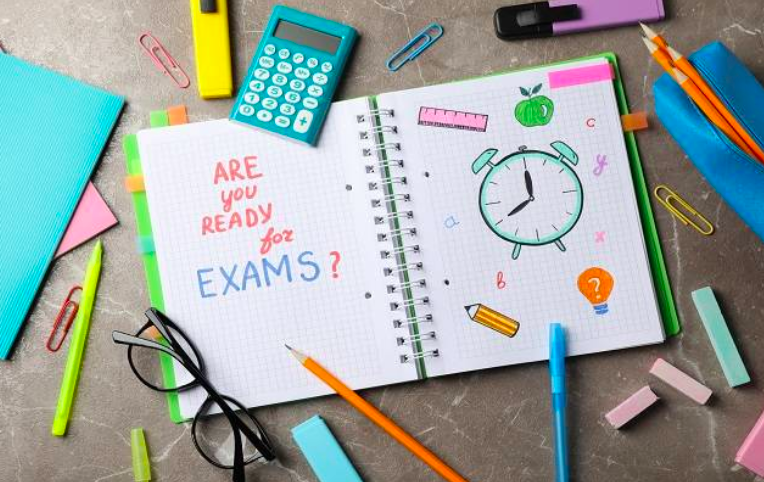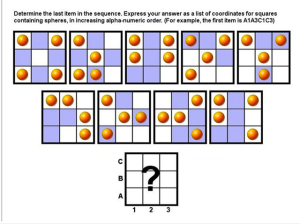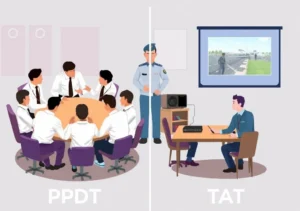NDA Exam stands for National Defence Academy Examination. We also call it NDA & NA (Naval Academy) exam. This is because it is a combined exam for selecting the officers for Army, Navy & Air Force.

NDA Exam
UPSC (Union Public Service Commission) conduct this exam twice in a year. 12th class passed or appearing candidates can give NDA exam. After passing written exam, candidates are called for SSB interview. Recommended & medically fit candidates join National Defence Academy located at Khadakwasla (Pune), where they will undergo training for approx.
Three years out of that 2½ years training is common for three wings. Then army cadets go to Indian Military Academy (Dehradun) for 1 year training, naval cadets to Naval Academy (Ezhimala) for 1 year training and air force cadets to Air Force Academy (Hyderabad) for further 1½ year training.
Also Read :
6 Tips to Pass NDA Exam in 1st Attempt
NDA Exam Eligibility Criteria
| Defence Wing | Age Limits | Educational Qualifications |
| For Army wing | 16½-19½ Years | 12th class pass or equivalent |
| For Naval wing | 16½-19½ Years | 12th pass with Physics & Mathematics or equivalent |
| For Air Force wing | 16½-19½ Years | 12th pass with Physics & Mathematics or equivalent |
NDA Exam Scheme
Written part consist of 2 papers i.e. Mathematics & General Ability Test (GAT). Mathematics paper is of 300 marks and GAT is of 600 marks. 2nd paper is further divided into two parts, part A & part B. Part A is English of 200 marks and Part B is General Knowledge is of 400 marks.
| Paper | Max. Marks | No. of Questions | Time Period |
| Mathematics | 300 | 120 | 2:30 Hours |
| Gen. Ability Test (English + GK) | 600 | 150 | 2:30 Hours |
NDA Marking Scheme
| Paper | Right Answer | Wrong Answer |
| Mathematics | +2.5 Marks | -0.83 Marks |
| Gen. Ability Test (GAT) | +4 Marks | -1.33 Marks |
- Written part consist of 900 marks and SSB interview also consist of 900 marks. All India Merit List is made on basis of these marks.
- There is a sectional Cutoff in NDA exam.
NDA Exam Schedule
| NDA I | NDA II | |
| Notification | December | May |
| Download Admit Card | March | July |
| Written Exam | April | August |
| Written Result | August | Oct.-Nov. |
| Training Starts | Dec-Jan. | June-July |
NDA Syllabus
Paper 1- Mathematics
Algebra:
- Concept of a set, operations on sets, Venn diagrams. De Morgan laws. Cartesian product, relation, equivalence relation. Representation of real numbers on a line. Complex numbers – basic properties, modulus, argument, cube roots of unity. Binary system of numbers. Conversion of a number in decimal system to binary system and vice-versa. Arithmetic, Geometric and Harmonic progressions. Quadratic equations with real coefficients. Solution of linear inequations of two variables by graphs. Permutation & Combination. Binomial theorem & its applications. Logarithms and their applications.
Matrices and Determinants:
- Types of matrices, operations on matrices Determinant of a matrix, basic properties of determinant. Adjoint and inverse of a square matrix, Applications – Solution of a system of linear equations in two or three unknowns by Cramer’s rule and by Matrix Method.
Trigonometry:
- Angles and their measures in degrees and in radians. Trigonometrical ratios. Trigonometric identities Sum and difference formulae. Multiple and Sub-multiple angles. Inverse trigonometric functions. Applications – Height and distance, properties of triangles.
Analytical Geometry of two and three dimensions:
- Rectangular Cartesian Coordinate system. Distance formula. Equation of a line in various forms. Angle between two lines. Distance of a point from a line. Equation of a circle in standard and in general form. Standard forms of parabola, ellipse and hyperbola. Eccentricity and axis of a conic .
- Point in a three dimensional space, distance between two points. Direction Cosines and direction ratios. Equation of a plane and a line in various forms. Angle between two lines and angle between two planes. Equation of a sphere.
Differential Calculus:
- Concept of a real valued function domain, range and graph of a function. Composite functions, one to one, onto and inverse functions. Notion of limit, Standard limits – examples. Continuity of functions – examples, algebraic operations on continuous functions. Derivative of a function at a point, geometrical and physical interpreatation of a derivative – applications. Derivatives of sum, product and quotient of functions, derivative of a function with respect of another function, derivative of a composite function. Second order derivatives. Increasing and decreasing functions. Application of derivatives in problems of maxima and minima.
Integral Calculus and Differential equations:
- Integration as inverse of differentiation, integration by substitution and by parts, standard integrals involving algebraic expressions, trigonometric, exponential and hyperbolic functions. Evaluation of definite integrals – determination of areas of plane regions bounded by curves applications. Definition of order and degree of a differential equation, formation of a differential equation by examples. General and particular solution of a differential equation, solution of first order and first degree differential equations of various types – examples. Application in problems of growth and decay.
Vector Algebra :
- Vectors in two and three dimensions, magnitude and direction of a vector. Unit and null vectors, addition of vectors, scalar multiplication of vector, scalar product or dot product of two-vectors. Vector product and cross product of two vectors. Applications-work done by a force and moment of a force, and in geometrical problems.
Statistics:
- Classification of data, Frequency distribution, cumulative frequency distribution – examples Graphical representation – Histogram, Pie Chart, Frequency Polygon – examples. Measures of Central tendency – mean, median and mode. Variance and standard deviation – determination and comparison. Correlation and regression.
Probability:
- Random experiment, outcomes and associated sample space, events, mutually exclusive and exhaustive events, impossible and certain events. Union and Intersection of events. Complementary, elementary and composite events. Definition of probability – classical and statistical – examples. Elementary theorems on probability – simple problems. Conditional probability, Bayes’ theorem – simple problems. Random variable as function on a sample space. Binomial distribution, examples of random experiments giving rise to Binominal distribution.
Paper 2- General Ability (English+GK)
Part A
English:
- The question paper in English will be designed to test the candidate’s understanding of English and workman like use of words. The syllabus covers these topics: Grammar and usage, vocabulary, comprehension and cohesion in extended text to test the candidate’s proficiency in English.
Part B
General Knowledge:
- The question paper on General Knowledge will broadly cover the subjects : Physics, Chemistry, General Science, Social Studies, Geography and Current Events.
Section A – Physics:
- Physical Properties and States of Matter, Mass, Weight, Volume, Density and Specific Gravity, Principle of Archimedes, Pressure Barometer.
- Motion of objects, Velocity and Acceleration, Newton’s Laws of Motion, Force and Momentum, Parallelogram of Forces, Stability and Equilibrium of bodies, Gravitation, elementary ideas of work, Power and Energy.
- Effects of Heat, Measurement of temperature and heat, change of State and Latent Heat, Modes of transference of Heat.
- Sound waves and their properties, Simple musical instruments.
- Rectilinear propagation of Light, Reflection and refraction. Spherical mirrors and Lenses. Human Eye.
- Natural and Artificial Magnets, Properties of a Magnet, Earth as a Magnet.
- Static and Current Electricity, conductors and Non-conductors, Ohm’s Law, Simple Electrical Circuits, Heating, Lighting and Magnetic effects of Current, Measurement of Electrical Power, Primary and Secondary Cells, Use of X-Rays.
- General Principles in the working of the following : Simple Pendulum, Simple Pulleys, Siphon, Levers, Balloon, Pumps, Hydrometer, Pressure Cooker, Thermos Flask, Gramophone, Telegraphs, Telephone, Periscope, Telescope, Microscope, Mariner’s Compass; Lightening Conductors, Safety Fuses.
Section B – Chemistry:
- Physical and Chemical changes. Elements, Mixtures and Compounds, Symbols, Formulae and simple Chemical Equations, Law of Chemical Combination (excluding problems). Properties of Air and Water.
- Preparation and Properties of Hydrogen, Oxygen, Nitrogen and Carbon dioxide, Oxidation and Reduction.
- Acids, bases and salts.
- Carbon – different forms
- Fertilizers – Natural and Artificial
- Material used in the preparation of substances like soap, Glass, Ink, Paper, Cement, Paints, Safety Matches, and Gun-Powder.
- Elementary ideas about the Structure of Atom, Atomic, Equivalent and Molecular Weights, Valency.
Section C – General Science:
- Difference between the living and non- living.
- Basis of Life – Cells, Protoplasms and Tissues.
- Growth and Reproduction in Plants and Animals.





